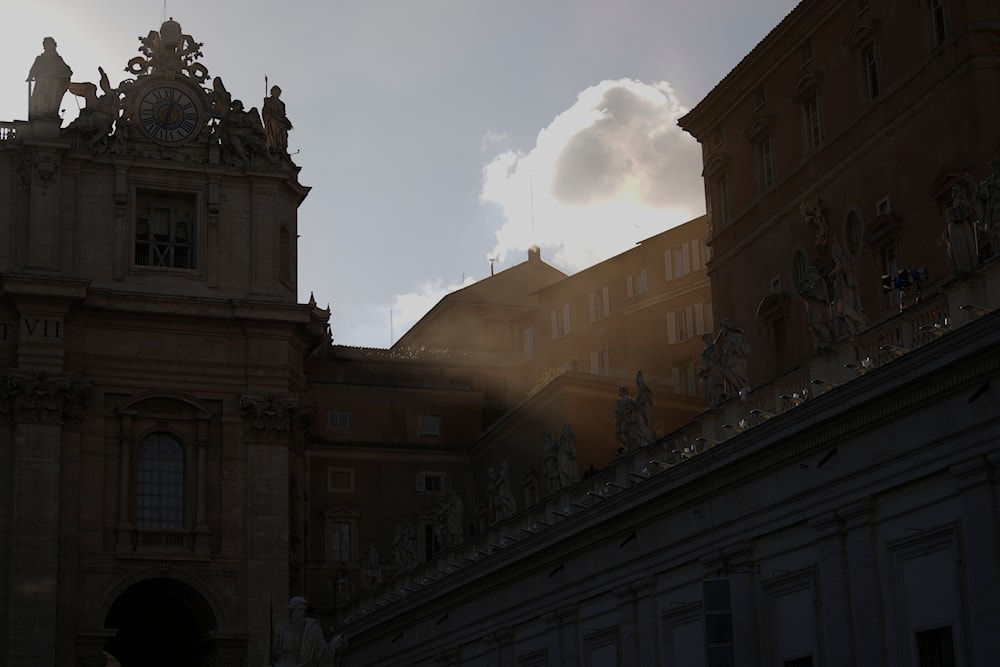White smoke rises: US Cardinal Prevost elected Pope Leo XIV - Vatican
A new era begins for the Catholic Church as cardinals elect US Robert Francis Prevost as the successor of Pope Francis, amid global uncertainty and mounting internal challenges.
-

White smoke billows from the chimney of the Sistine Chapel during the conclave to elect a new pope, at the Vatican, Thursday, May 8, 2025 (AP)
USA Cardinal Robert Prevost was elected in a surprise choice as the new pope and leader of the Roman Catholic Church on Thursday, a senior cardinal announced to crowds in St. Peter's Square.
Upon his election, he chose the name Leo XIV, in honor of Pope Leo XIII, known for his support of social justice causes.
Prevost becomes the first US pope in Catholic Church history.
A moderate who was close to Pope Francis and spent years as a missionary in Peru, he became the Catholic Church's 267th pontiff with at least 89 votes, i.e. a majority of two-thirds of the voting cardinals.
'Habemus Papam'
Pope Leo appeared on the central balcony of St. Peter's Basilica around 70 minutes after white smoke billowed from a chimney atop the Sistine Chapel, signifying the 133 cardinal electors had chosen a new leader for the 1.4 billion-member Catholic Church.
French Cardinal Dominique Mamberti announced the choice of Prevost with the Latin words "Habemus Papam" (We have a pope) to tens of thousands of people gathered in St. Peter's Square to hear the news.
Aged 69 and originally from Chicago, Prevost has spent most of his career as a missionary in Peru and became a cardinal only in 2023.
Thousands of worshippers and tourists had gathered in anticipation, their eyes fixed on the balcony from where the pope made his first appearance. The traditional signal came after two days of closed-door deliberations by the College of Cardinals.
The conclave that produced the new pope was the largest in Church history, with 133 cardinals from across five continents taking part. Bound by secrecy and threatened with excommunication for leaks, the cardinals cast their votes in silence. Their only communication with the outside world came through the centuries-old signal system: black smoke for indecision, white for a final decision.
After black smoke disappointed onlookers on Wednesday evening and again on Thursday afternoon, the breakthrough came with the white smoke's appearance, confirming the successful election.
According to tradition, the newly elected pope retreats to the “Room of Tears,” where he dons the white cassock for the first time and receives pledges of obedience from the cardinals. Soon after, he appears on the balcony of St. Peter’s Basilica to be introduced in Latin and to deliver his first Urbi et Orbi blessing, “To the City and the World.”
Church faces global and internal challenges
This election follows the death of Pope Francis last month. Francis, the first Latin American pope, served for 12 years and was widely regarded as a reformer focused on compassion, migration, and environmental justice. His tenure, however, was marked by both praise and frustration, particularly from traditionalists within the Church.
The cardinals' choice came amid a rapidly changing global landscape. Internally, the Church is struggling with declining vocations, an aging clergy, and shrinking attendance across Western parishes. Externally, the world is witnessing rising nationalism, political fragmentation, and ongoing wars that test the moral voice of religious institutions.
Before the conclave began, Cardinal Giovanni Battista Re, dean of the College of Cardinals, urged electors to choose a figure capable of safeguarding Church unity in a fractured world.
Formal inauguration in a week
The formal inauguration mass is expected within a week and will be attended by global religious and political figures. The pope will also begin his pastoral duties with a tour of St. Peter’s Square in the popemobile, offering his vision and message to the Church at a critical turning point.
Who is Pope Leo XIV?
Robert Francis Prevost, Pope Leo XIV, was born in Chicago, Illinois, on September 14, 1955.
He joined the Order of Saint Augustine in 1977 and took his final vows in 1981.
Prevost became a Peruvian citizen in 2015, solidifying a decades-long bond with the South American nation.
His connection to Peru began in the mid-1980s when he served as an Augustinian missionary.
Positions
Though he returned to the United States in 1999, Prevost resumed his work in Peru 15 years later, taking up leadership of the Diocese of Chiclayo in the country’s north and eventually becoming the city’s archbishop.
He held that post until 2023, when Pope Francis appointed him as head of the Vatican’s influential Dicastery for Bishops following the resignation of Canadian Cardinal Marc Ouellet and the head of the Pontifical Commission for Latin America, both prominent positions within the Vatican.
In a poignant moment during his first public address as pope on Thursday, Leo XIV spoke briefly in Spanish to honor the people of Chiclayo, highlighting the enduring significance of his Peruvian ties.
Education
Leo graduated from the College of Liberal Arts and Sciences (CLAS) at Villanova University in 1977, according to the school. He received a Bachelor of Science degree in mathematics in 1977 from Villanova, one of two Augustinian Catholic institutions of higher learning in the US, before earning a Master of Divinity degree from Catholic Theological Union in Chicago in 1982. That same year, he was ordained as a priest.
After graduating from Villanova and CTU, Pope Leo earned both licentiate (1984) and doctorate (1987) degrees in canon law from the Pontifical College of St. Thomas Aquinas in Rome.
In 2014, Villanova awarded him an honorary Doctor of Humanities degree.

 5 Min Read
5 Min Read








